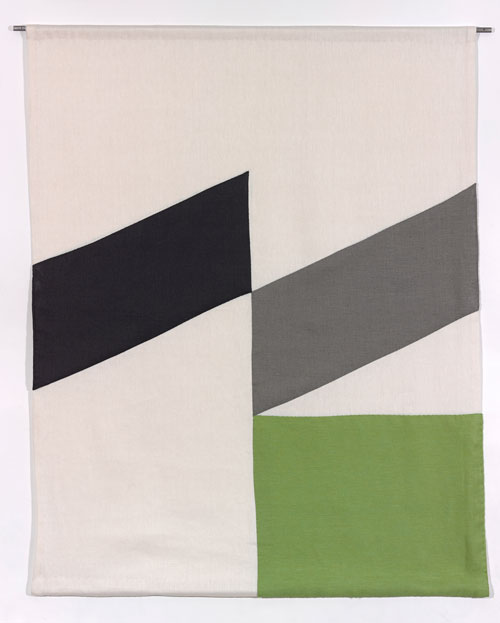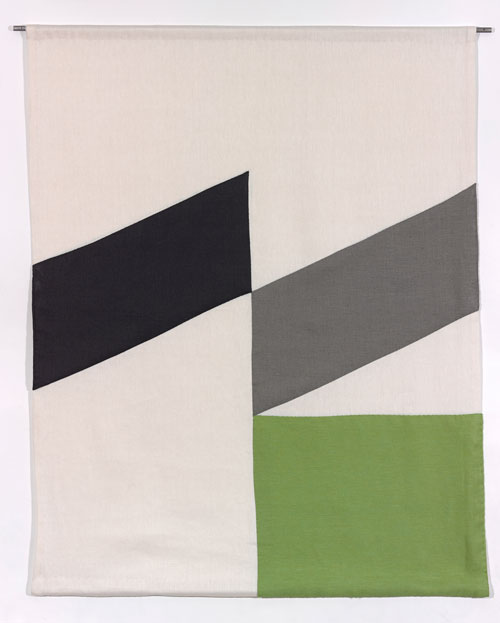
Starting October 11th, Maine artist Karen Gelardi‘s new exhibition, Standard, will be hanging in our annex. We talked to her about this project, her dream workspace, and the materials she most enjoys working with. Come by October 18th for her artist’s talk!
You work in a variety of mediums — printing, painting, sewing. Can you talk a bit about your background as an artist? Do you have a favorite material to work with?
I studied painting and always think of myself as a painter. Adding, subtracting—working back and forth. My favorite medium is ink on paper although I like to make things hard for myself and started making drawings using cut and appliqued fabric about 7 years ago. I wanted to make paintings that were not stretched canvas, where the surface is an object itself. And the work was portable and not a precious object but something more familiar that could be handled. I also wanted the color itself to be an object. It may come out of so much computer time and wanting my work to be the opposite of that where the construction of the image was very tangible. My instinct to shift from one medium to another may be connected to the fact that when I moved back to Maine after art school, I began working in the design field, eventually working as a product designer where I have to think in terms of different materials and applications. I really love the exercise of translating an idea into various formats.
How did the Standard banners come about as a project?
I received a request to do a commissioned textile project and that work evolved into a series of 120 textile designs coming from my applique banner drawings and the work I had done with New Factories. For the Standard project, I wanted to create banners that were more minimal and conceived as works to be manufactured in a workshop environment. To standardize the production process, all are 32″ x 40″ and use a limited number of rectangles, triangles, and parallelograms. The project format is heavily influenced by the idealism of the Bauhaus where all of the arts would be mixed together.
You had a team of artists helping you hand-stitch these pieces, right? Can you talk about the experience of having a team produce your designs?
Yes, my workshop, New Factories, is producing the pieces for me. It allows me to focus on the ideas and the intent rather than feeling overwhelmed by the physicality of all of the production work. The workshop— or more accurately— network of makers—has produced work for other artists and collectively moved mountains that individually you couldn’t even consider tackling. There is power to setting you vision, and then letting people help you produce the work. To problem solve together, deal with logistics, divide up the number of hours it takes and share that amongst a group—it is amazing. All of the pieces are hand-stitched— there is no machine sewing in these works. I am interested in 3D printing, on-demand production, and mass customization. The project is about playing out these practices with manual production methods and individuals rather than the high-tech version. The high-tech manufacturing practices are still in their infancy. I am interested in modeling the process and possibilities with projects like Standard.
Two-part question: How do you define painting? Do you consider these banners paintings?
Painting is a constructed image and/or idea. I consider the banners to be drawings. I think of them this way because you can see the fabric ground and they are made in a very direct way. If the entire surface was addressed, I may think of them as paintings. This body of work, more than any of my others, is connected to a design process. I don’t usually pre-plan my work and then execute the idea— but this series is made in that way. So I think it is fair to also consider these as designed objects. The banners could also be seen as a product in that they are commissioned works and I knew they would have to exist in the world as something sold within a market.
What’s your studio like? What would be your dream space to work in?
My current studio is the New Factories space which is a cottage industry workshop with tools and materials set up specifically to produce the Standard project. There are racks, and hooks, material storage, and specially designed work tables. My dream space would be just like the current space but 10 times bigger with an area set up just as methodically but for drawing and painting, with another area for an office/library. Must have a loading dock and great light
What’s one word that describes your creative process?
Adaptable.
What’s inspiring you right now — any particular books, films, artists, food, music?
Why is that such a hard question? Hmm. Well, I am inspired by my garden right now and the change of seasons. This was the first year where we really took advantage of the apples from the apple tree—thanks to my sister. I love the light this time of year. Peach jam from my peach tree is pretty amazing (thanks, again to my sister). A huge stack of Art Forum magazines I am going to delve into this winter (thanks, Mark Wethli!). Every recipe from Chris Boswell’s Verdure cookbook. Pistachio cake from Tandem’s new bakery. I am in desperate need of some new music and audio books as we have many hours of sewing ahead!

